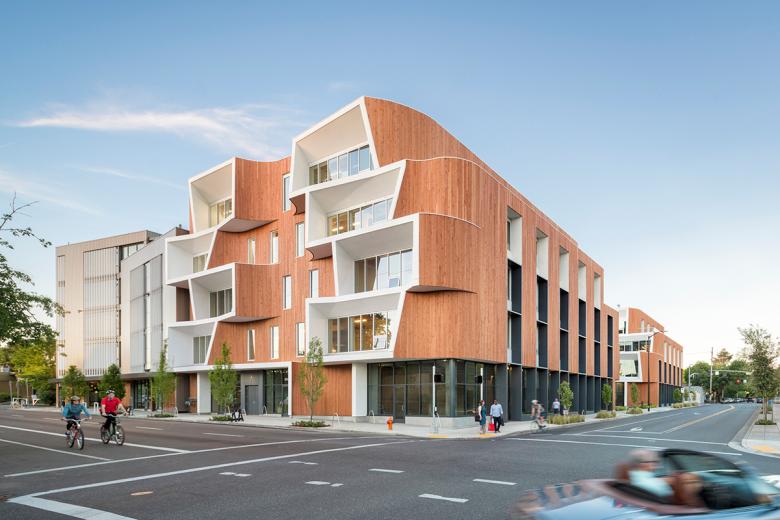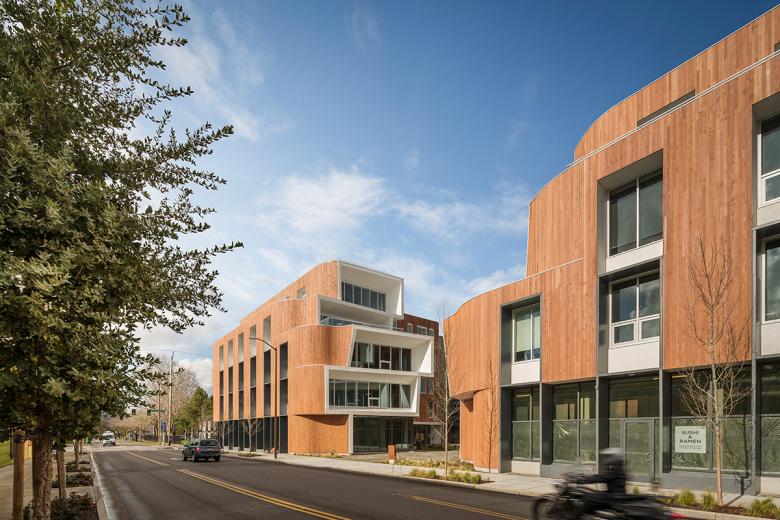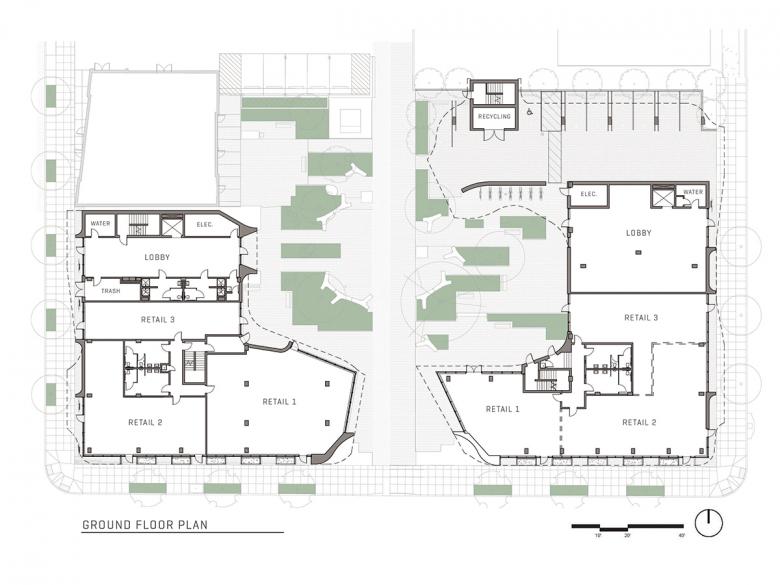U.S. Building of the Week
One North
Holst Architecture
11. September 2017
Photo: Andrew Pogue
From the street, One North is a daring mixed-use project that attracts a fair amount of attention through its wood-clad elevations that curve into projecting glazed portals. On the inside, the buildings create a courtyard, a public space for residents of Portland, while behind the facades are timber-framed office spaces filled with natural light. Holst Architecture answered some questions about the sustainably minded project.
Location: Portland, Oregon, USA
Client: Karuna Properties
Architect: Holst Architecture
Project Team: Kevin Valk, Cassidy Bolger, Lee Jorgensen, Cory Hawbecker
Structural Engineer: Froelich Structural Engineers
MEP/FP Engineer: McKinstry
Landscape Architect: Lango Hansen
Lighting Designer: Biella Lighting Design (interior lighting)
Interior Designer: Osmose Design (partial tenant fitout)
Construction Manager: R&H Construction (buildings), Hammer & Hand (tenant interior fitout)
Design/fabrication of aperture structures/curved components: Radius Track
Site Area: 52,500 sf
Building Area: 85,540 sf
Photo: Holst Architecture
What were the circumstances of receiving the commission for this project?
The client chose Holst based on our previous working relationship and our reputation for innovative, sustainable architecture.
Photo: Andrew Pogue
Please provide an overview of the project.
One North is an innovative mixed-use commercial development designed with a clear set of values involving community, environment, and resiliency. The project provides commercial office and retail space on a brownfield site, with a focus on maximizing energy efficiency, reducing waste and consumption, and sharing resources with the community. Coupled with a strong commitment to neighborhood values and collaboration, One North represents an entirely different approach to commercial building.
Photo: Andrew Pogue
Composed of three mixed-use office buildings with ground-floor retail, the One North development surrounds a new 14,000 square feet courtyard intended to create a vibrant community space for use by both tenants and the neighborhood. Purpose-built to achieve exceptional energy efficiency through a blend of leading-edge strategies, the Karuna East (4 stories; 43,400 sf) and West (5 stories; 35,600 sf) Buildings at One North were modeled to perform 50% more efficiently than a typical new building in Oregon. They are expected to use about 1/3 the amount of energy as the average US office building, including existing buildings. Both buildings feature concrete construction on the retail ground floor, with exposed heavy timber post and beam structure at the office spaces above the elevated post-tensioned concrete podium.
Photo: Andrew Pogue
What are the main ideas and inspirations influencing the design of the building?
The client had ambitious project objectives. He didn’t want One North to be a one-off; he hoped that the lessons learned from the project could be shared with the community and that the favorable return on investment would encourage other developers to adopt similar sustainability goals. The origin of and inspiration for the building’s curving facades and window openings was the client’s passion for the architecture of Antoni Gaudí.
Rather than seeking third party recognition of sustainability efforts for the project, the client had his own interpretation of the level of excellence the project would achieve. To that end, heightened standards for energy performance, ethical material sourcing and building practices, and a commitment to the values of the North Portland neighborhood all contributed to the client’s vision for a sustainable, lasting development.
Photo: Andrew Pogue
How does the design respond to the unique qualities of the site?
Building in a neighborhood that has undergone gentrification for several years, the client wanted to mitigate rather than contribute to the problem. The quickly changing neighborhood suffers from a lack of open spaces for the community, so the team decided early on to dedicate land for public use. The 14,000-square foot public courtyard between the East and West Buildings is open to the public in perpetuity. The vision for the courtyard was to allow the neighborhood to have accessible new opportunities and to foster community events
Photo: Andrew Pogue
How did the project change between the initial design stage and the completion of the building?
Holst’s dual emphasis on design and quality technical execution often results in projects that maintain the integrity of their design concepts; the renderings and final photographs of the buildings are nearly indistinguishable. The design team worked closely with the contractor to ensure that the complex framing geometries of the curved and cantilevered building forms were accurate and achievable.
The project was originally conceived as a speculative office building with a variety of small to medium sized spaces. During construction, the digital creative agency Instrument signed on to rent three full floors of the East building. Instrument enlisted Holst to design their new home, which required a rethinking of the interior spaces and their connectivity to the lobby and to each other.
Photo: Andrew Pogue
Instrument’s new home supports the agency’s collaborative and fluid creative process with an open studio environment and central atrium space. The atrium acts as the internal courtyard connecting the three levels of office space, and encourages community building and spontaneous interaction.
Instrument’s team structure and design process informed the interior layout, with special attention paid to the dynamic office culture. The client desired an environment where people can move seamlessly between solo and collaborative work. A wide variety of spaces support a diverse range of working styles: large stand-up tables and lounge areas let groups break away from their desks; bar seating and cubbies give individuals places to focus; and enclosed meeting rooms are designed for group video conferencing and whiteboarding.
The atrium acts as the internal courtyard connecting the multiple levels of office space, and encourages community building and spontaneous interaction. Special attention was paid to Instrument's dynamic office culture. Spaces for gathering maintained the utmost importance throughout the project.
Photo: Andrew Pogue
Was the project influenced by any trends in energy-conservation, construction, or design?
Additional sustainability strategies include a super-insulted airtight building envelope, exterior shading, a structure made primarily of wood, highly efficient mechanical systems, and the near-elimination of thermal bridges. The East & West Buildings both have photovoltaic arrays for on-site electrical production (totaling 71 kw), thermally broken doors and windows for energy efficiency, and insulation on all sides of the buildings, including the foundation. Minimal on-site parking encourages public transportation, walking, and bicycling.
Photo: Andrew Pogue
What products or materials have contributed to the success of the completed building?
The buildings’ unique curves are complemented by its Western Red Cedar siding, a feature that also reflects the project team’s commitment to exceeding industry standards. The team chose second-growth wood to avoid the negative environmental impacts of using old growth cedar, hand-sourced domestically harvested wood, met the individuals logging and milling the material, and ran a custom 5/4” profile for increased durability.
Email interview conducted by John Hill.
Ground Floor Plan (Drawing: Holst Architecture)
Sustainability Diagram (Drawing: Holst Architecture)
Related articles
-
Laura’s Place
on 12/4/17
-
One North
on 9/11/17
-
Garden House
on 7/17/15
-
Pavilion House
on 7/6/15











